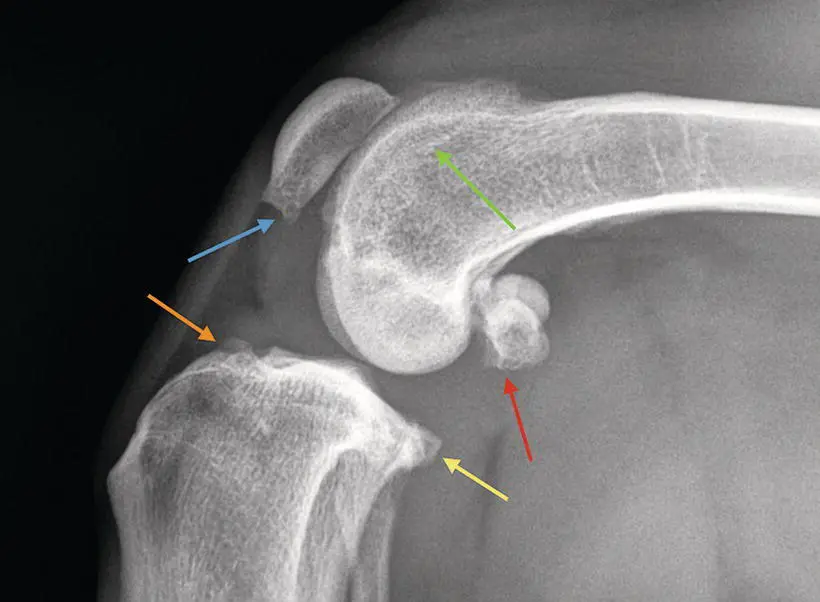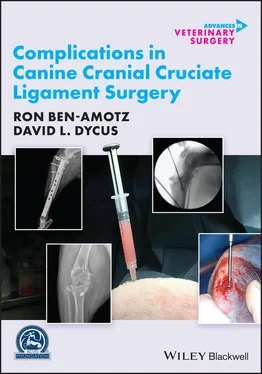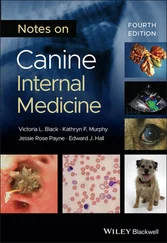1 ...8 9 10 12 13 14 ...24 
Figure 1.12 Evidence of degenerative changes in the stifle of a patient with CCL pathology. Commonly noted areas are the distal pole of the patella (blue arrow), cranial tibial plateau (orange arrow), caudal tibial plateau (yellow arrow), and fabella (red arrow). In addition, a small area of sclerosis can be seen around the trochlear groove (green arrow) indicative of synovitis or osteophytosis of the medial or lateral femoral trochlea.
While all correctly executed surgical procedures can stabilize the stifle, not one of these procedures ultimately restores completely normal stifle kinematics or kinetics. In defining a good outcome, should we consider a stable stifle to be the predominant deciding factor? Interestingly, work has been completed that demonstrates ongoing instability following surgical stabilization [16, 25], yet retrospective and client assessment studies have shown high success rates with certain procedures. What about return to function? Success rates among all surgical procedures are in the high 80% to low 90% range when evaluating most retrospective studies. While this suggests that most surgical procedures do a good job of returning canines to “normal” function, probably the best way to tell would be return to sport or work for our canine athletes. Recent data have suggested that following TPLO, agility dogs have a good prognosis for return to sport [26].
Elimination of progression of OA has been stated as a possible determination of outcome and goal of treatment. This is likely not an achievable feat. Once the CCL has become damaged and instability in the stifle is present, there is abnormal joint loading. Thus, damage to the chondrocytes has occurred. Therefore, it is probably better to evaluate surgical stabilization procedures in terms of which are the most capable of slowing down and minimizing progression of OA, rather than which can eliminate it entirely.
1.4 Defining a Complication
The ability to recognize and manage complications should be considered when choosing a surgical procedure. Generally, the complication rate of currently practiced surgical stabilization procedures is low, but individual techniques are associated with their own unique set of potential complications and it is of the utmost importance that the clinician is familiar with the management of these complications prior to undertaking the initial procedure. In the past, much focus has been on the actual surgical procedure and training of how to perform it. Unfortunately, what is missed is how to identify patients that might be at an increased risk of complications, how to identify intraoperative complications, decision making to avoid intraoperative complications, recognition of postoperative complications, and how to revise complications in the postoperative period should they occur.
1.4.1 Assessment of Success and Complications
Although a high success rate (intended outcome) is important when deciding to perform a surgery, the risk of an unintended outcome, severity of potential adverse events, and owner financial burden need to be considered and communicated to the owner. Avoiding iatrogenic harm should be an emphasis of all practicing veterinarians. In veterinary orthopedics, standardized definitions of complications have been suggested in an attempt to improve consistency and comparability in veterinary orthopedic research [27]. For example, a method to classify catastrophic, major and minor complications has been published so results between studies can be accurately translated and to allow the clinician to decide if an intervention causes unacceptable morbidity.
One method to quantify success and harm factors is a ratio between the number of patients needed to treat (NNT) and number needed to harm (NNH). NNT is defined as:

where attributable risk is the difference between the frequencies of a successful outcome between two interventions. The NNT assesses how many patients would have to be treated with one treatment compared to another before there would be one additional positive outcome. For example, if surgery A had a success rate of 75% and surgery B had a success rate of 67%, the NNT would be 13 (1/(0.75−0.65) = 12.5); the result of 12.5 was rounded up to the nearest whole number to make the result more clinically relevant and prevent overestimating the benefit of surgery A. This means that surgery A would have to be performed on 13 patients before one additional beneficial outcome would be seen. In human medicine, a single‐digit result is generally considered a good NNT [28].
Conversely, NNH assesses how many patients need to be treated with one treatment compared to another before you would see one additional complication. NNH is calculated similar to NNT but with complication frequencies. When calculating NNH, a specific complication(s) needs to be selected. For example, if surgery A had an infection rate of 10% and surgery B had an infection rate of 0%, the NNH would be 10. This means that one more infection would be seen for surgery A after completing 10 surgeries. A target NNH depends on the severity of the complication being assessed. A single‐digit NNH may be acceptable for a minor complication such as incisional redness compared to a NNH of 100 for a major complication like implant infection.
For both NNT and NNH, it is also important to evaluate the overall frequency of success, or a complication, to direct clinical decision making. For example, if the NNH is 10 but the overall frequency of infection is 90% vs 80%, a clinician may conclude neither procedure should be used.
Finally, likelihood to be helped or harmed (LHH) can be calculated (NNH:NNT). A number >1 tells us that the treatment is that many times more likely to help than to harm. Using the above example, surgery A has a LHH of 10/13 = 0.77. When the LHH is <1, the treatment is more likely to harm than to help. A LHH <1 is usually only acceptable when the complication assessed is minor or transient. The more serious the complication assessed, the higher the desired LHH.
Other considerations when discussing complications include the effect of duration of follow‐up and unique complications to the procedure. Time after an intervention can influence success and complication rate; a longer follow‐up period may allow for an improved treatment response but also allows for a greater opportunity for an unintended outcome, like OA. In veterinary orthopedics, 12 months has been defined as the length of “long‐term” follow‐up; this terminology is reasonable but has been inconsistently followed [27].
It is important that statistical and clinical significance is considered when designing a study and interpreting results. Statistical significance is an important scientific evaluation of a dataset, but it is important to remember that it may be of little or no value when considering the care of an individual patient [29, 30]. One consideration is that investigations that include large sample sizes can result in clinically unimportant variables gaining statistical significance.
Although a p value is a common method to inform us of a statistical difference between groups, effect size and minimal clinically important difference (MCID) should also be investigated. Effect size helps quantify the magnitude of the difference observed and is not influenced by sample size. It is calculated by finding the difference between the means of two groups and dividing the result by the standard deviation [31]. Cohen suggested 0.2 is a small effect size, 0.5 is an average effect size, and 0.8 is a large effect size. For perspective, when there is an effect size of 0.8, 79% of the treatment group will be above the mean of the control group (a reference chart can provide this information for all effect size values).
Читать дальше














